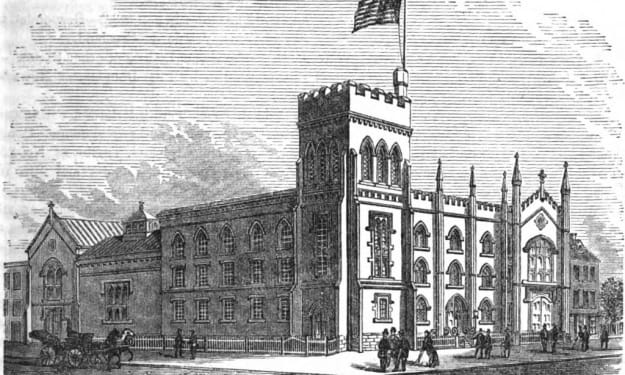A House Divided
Democratic Convention 1856,1860

Second in a 20 party series on the history of the Democratic Convention
1856: Pierce Gets Rejected
Date: June 2-6, 1856
Venue: Smith and Nixon Hall, Cincinnati, Ohio. Smith and Nixon was a major piano manufacturer, and they set up the hall as a demonstration venue for their products. The auditorium was on Fourth Street between Walnut and Main. Today it is part of commercial downtown.
Events: Buchanan, who had been seeking the presidency for years, finally got his shot in 1856. Franklin Pierce did seek the nomination, and while he started strong, his support declined steadily. A bitter Pierce made a last ditch effort to kill Buchanan’s chances by throwing his support to Stephen Douglas of Illinois . It failed, and Buchanan wound up winning with 296 votes on the 17th ballot. Delegates would select 35 year old Kentucky Congressman John Breckenridge as the vice presidential nominee.
November: Buchanan defeated John C Fremont of the newly created Republican party by a fairly large margin. Former president Millard Fillmore managed to get 21 percent as the candidate of the Know Nothing Party. Buchanan is generally ranked as one of the worst presidents in history, as his support of the Slave Power was a major factor leading to the Civil War.
1860: A Tale of Three Conventions
The Democratic Party actually had three conventions during 1860. And if you think slavery had something to do with it, you were paying attention in history class.
Convention 1: April 23 – May 3, 1860
Venue: South Carolina Institute Hall, 134 Meeting Street, Charleston SC. While the building burned down in 1861, several plaques note its location. Only seven months after Democrats met, the building held the signing of the Ordinance of Secession on December 20.
Events: Stephen Douglas of Illinois was the leading candidate from the start, but southern delegates refused to support him, denying him the 2/3rd he needed for the nomination. Pro-slavery delegates known as “Fire Eaters” were led by William Yancey of Alabama; they objected to Douglas’ more moderate views on the issue of slavery. Eventually, all of the delegates from the Deep South walked out of the Convention. After 57 ballots, delegates determined things were futile and decided to meet at a later date.
Convention 2: June 18-23, 1860
Venue: Front Street Theater, Front and Low Streets, Baltimore, Maryland. The building burned down in the fire of 1904. The site today is near the Main Baltimore Post Office.
Events: Delegates reconvened, and the Southern delegates once again walked out. After two ballots, it was clear Douglas had the votes of almost everyone left in the building, so he was declared the nominee. Senate Benjamin Fitzpatrick of Alabama was chosen as the vice presidential candidate, but he declined; Douglas asked Herschel Vespasian Johnson of Georgia to run with him and Johnson agreed.
The 1860 Platform stated it would abide by the Supreme Court on the issue slavery, meaning the Dred Scott decision of 1857 (the worst decision in the history of the Court). The platform also called for a coast to coast railroad, the acquisition of Cuba and supported the Fugitive Slave Law.
Convention 3: June 18-23, 1860
Venue: Maryland Institute, Baltimore and Frederick. The building was destroyed in the Baltimore fire of 1904. Today the site contains the Central District Baltimore Police Department station.
Events: The handful of Southern delegates who had fled the main convention nominated Vice President John Breckenridge for President and former governor/Senator Joseph Lane of Oregon for Vice President.
November 1860: Republicans nominated Abraham Lincoln of Illinois, who handily won the electoral college in a four-way race. Douglas and Breckenridge together got more votes (2.2 million) than Lincoln (1.86 million). Lincoln’s election led the southern states to secede, starting with South Carolina in December. A month after Lincoln’s inauguration, the Civil War began.






Comments
There are no comments for this story
Be the first to respond and start the conversation.